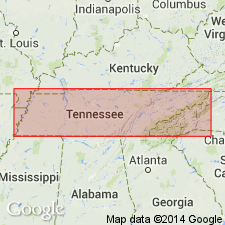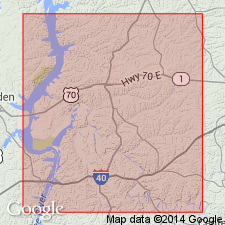
- Usage in publication:
-
- Beech River formation*
- Modifications:
-
- Named
- Dominant lithology:
-
- Shale
- Limestone
- AAPG geologic province:
-
- Cincinnati arch
Summary:
Named the Beech River formation for the Beech River, Decatur Co., TN. Consists almost exclusively of fine shales. Unit is highly fossiliferous, gray, yellow, and bluish, and weathers into white clay. Some beds of limestone exist. Thickness is 74 to 106 feet and is divided into a lower COCCOCRINUS zone, a middle TROOSTOCRINUS zone, and an upper EUCALYPTOCRINUS zone. The Beech River is considered the basal formation of the Brownsport group; it overlies the Dixon formation and underlies the Bob formation. Age is Silurian (Niagaran).
Source: GNU records (USGS DDS-6; Reston GNULEX).

- Usage in publication:
-
- Beech River Member*
- Modifications:
-
- Biostratigraphic dating
- AAPG geologic province:
-
- Cincinnati arch
Summary:
Used as Silurian Beech River Member of Brownsport Formation in du Pont Geohydrological Survey well near Waverly, Humphreys Co., central TN. Overall age of Brownsport is considered Wenlockian to Pridolian. Specimen of conodont PSEUDOONEOTODUS BICORNIS? at 607.4 to 608.4 ft in overlying Bob Limestone Member could indicate an early Ludlovian or older Wenlockian age for the Bob at that level.
Source: GNU records (USGS DDS-6; Reston GNULEX).
For more information, please contact Nancy Stamm, Geologic Names Committee Secretary.
Asterisk (*) indicates published by U.S. Geological Survey authors.
"No current usage" (†) implies that a name has been abandoned or has fallen into disuse. Former usage and, if known, replacement name given in parentheses ( ).
Slash (/) indicates name conflicts with nomenclatural guidelines (CSN, 1933; ACSN, 1961, 1970; NACSN, 1983, 2005, 2021). May be explained within brackets ([ ]).

